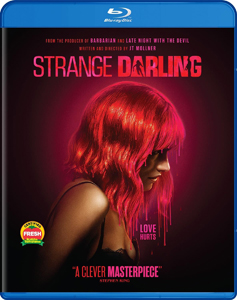In “Strange Darling” (2024), writer-director JT Mollner shows that one of cinema’s most generic plots – a serial killer on the prowl – can be flexible enough for a fresh commentary on human existence. In his second full-length movie (and first since 2016), Mollner gets on the map by telling a story out of order, playing with moviegoers’ expectations, and leaning on daring performances from Willa Fitzgerald and Kyle Gallner.
It’s impressive how “Strange Darling” tricked me despite presenting the truth in front of my face. There must be something magical about cliches, genres and tropes wherein we get drawn into them, even if it’s not the story being told in this instance.
Part of what draws us in is Fitzgerald, who even in “Scream: The TV Series” showed signs of range. Here she plays The Lady, on the run from The Demon (“Veronica Mars’ ” Gallner, also a horror veteran from the “Smile” films and more).
“Strange Darling” (2024)
Director: JT Mollner
Writer: JT Mollner
Stars: Willa Fitzgerald, Kyle Gallner, Ed Begley Jr.
Mollner presents the film as “a thriller in six chapters,” calling to mind the serial setup of “Furiosa” and “Zack Snyder’s Justice League” except that we start with chapter three, then jump around to the other five. Each chapter redefines what we’ve seen so far.
The familiar becomes fresh
It’s a gimmick, but it’s an essential gimmick that adds significant value — not only because the film would be flat if told chronologically, but also because new meanings emerge. Because the movie finishes rather predictably, I suspect Mollner got caught up in the coolness of the structure and didn’t realize he could’ve gone even further. Instead, “Strange Darling” is an easily accessible quirky film, because the foundation of the chaser and the chased stays in place.
But it makes us look at familiar scenarios from fresh angles. A harrowing motel-room sex scene is a stark example. Kinky foreplay looks like an assault until we’re armed with one more piece of information: The partners have agreed beforehand that “no” doesn’t mean no in their scenario; rather, “Mr. Snuffleupagas” means no.
Even though “Strange Darling’s” screenplay is out to toy with us, if we temporarily put ourselves in the place of the characters (of course, you don’t want to spend much time in their skin), we soak up the inconsistent subtleties of human interaction. Things are not always what they seem. Public behavior and private behavior are different. A staged crime scene and what literally happened are different.

Despite making a film with intense, real moments (enhanced by lush backcountry cinematography by Giovani Ribisi, best known for his acting), Mollner makes us think about how stories and truth – cinema and the real world – are different.
It comes not only from the cat and mouse figures, but also when random new characters get dragged into their orbit. Trust but be cautious. Be cautious but be human. Respect opinions of people who have been around the block, if they’ve earned it. Have fun watching “Strange Darling,” Mollner seems to say, but also stay alert.

